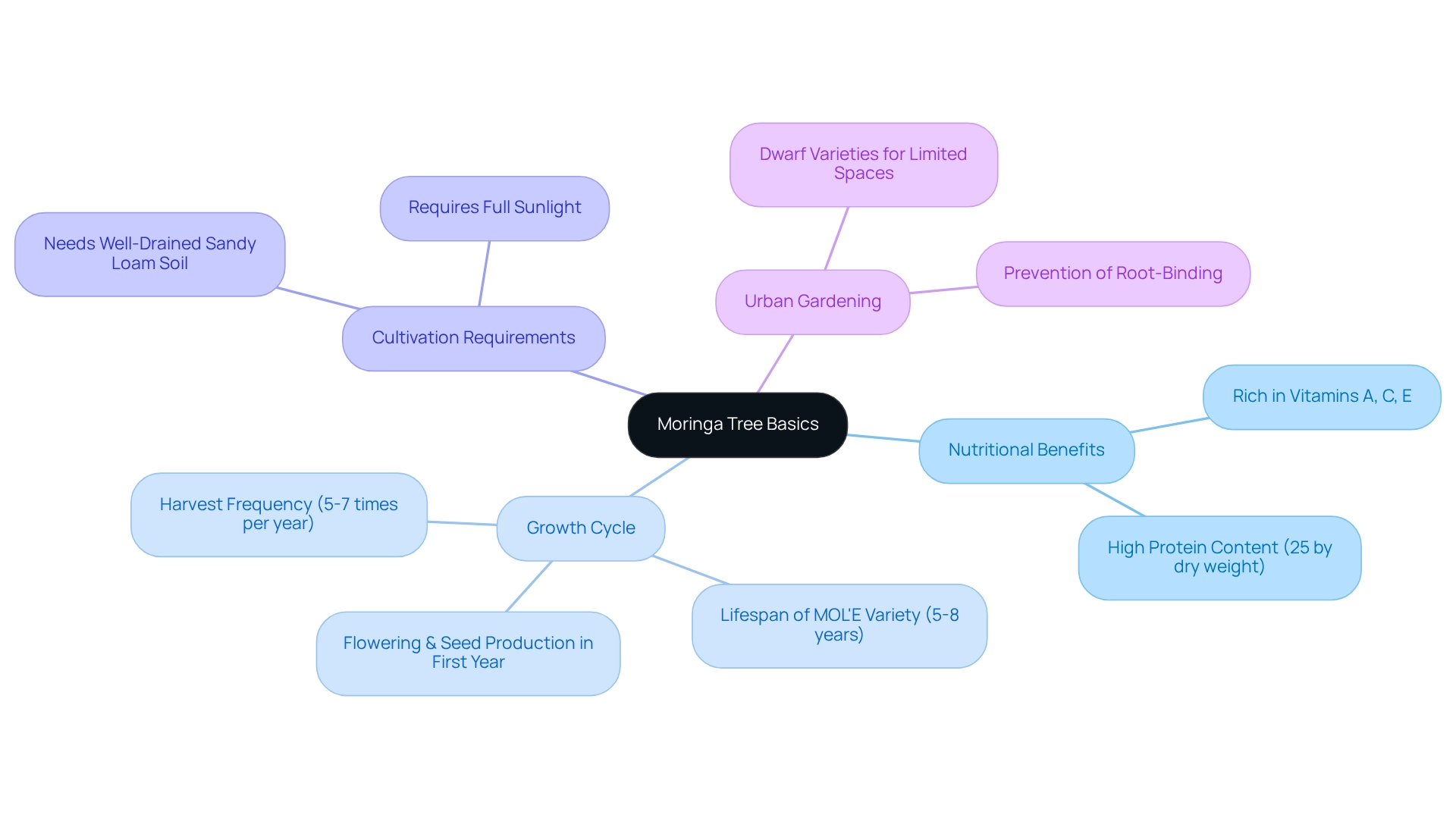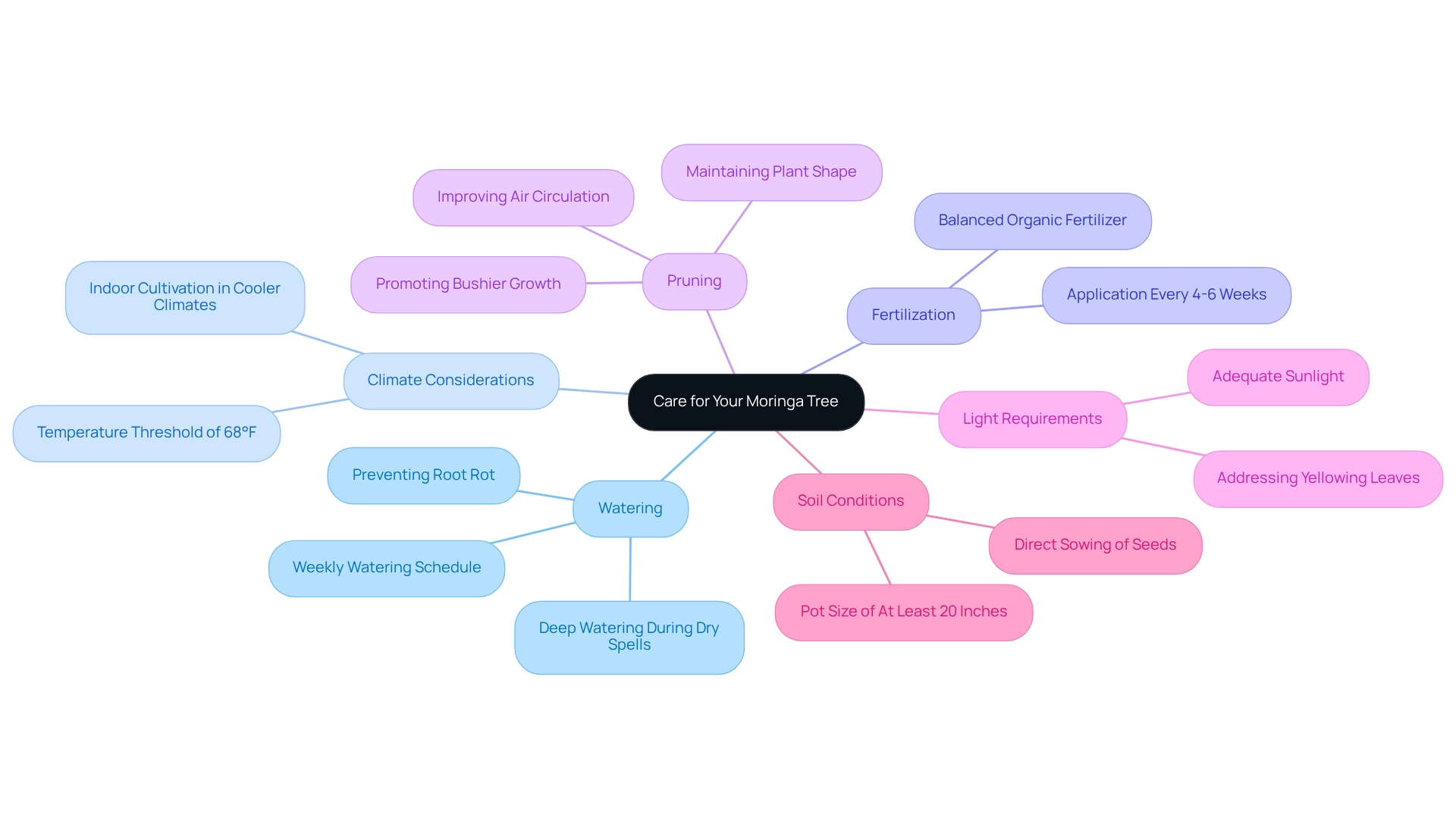If you're searching for a fast-growing, nutrient-rich plant that’s easy to care for and rewards you with edible leaves packed with vitamins — the Moringa tree is your answer.
Nicknamed the "Miracle Tree," it’s a favorite among home gardeners for a reason: it’s resilient, thrives in most climates, and adds beauty and nutrition to your yard. Whether you're gardening on a balcony or have acres to spare, Moringa can fit into your space.
Growing your moringa tree can be a rewarding experience, and following five essential steps can help you succeed:
- Prepare the planting site to ensure a nurturing environment.
- Plant the seeds or seedlings with care, as this is the foundation of your tree's growth.
- Remember to care for your tree through proper watering and fertilization, addressing any common issues that may arise along the way.
- Regular pruning is vital to maintain its health and shape.
Understanding the moringa tree's growth requirements is crucial. It thrives in sunlight and well-drained soil, which are key to ensuring healthy growth. By paying attention to these needs, you can maximize its nutritional benefits. As you embark on this gardening journey, remember that it's okay to face challenges; each step you take brings you closer to a flourishing moringa tree. You’ve got this!
👉 Looking to start your Moringa journey? Everglades Farm ships healthy Moringa trees straight from Florida to your door. Just plant, water, and enjoy.
The Moringa tree, often lovingly referred to as the "Miracle Tree," is more than just a beautiful addition to your garden; it’s a remarkable source of nutrition that brings a wealth of benefits for both your health and the environment. Its rapid growth, incredible resilience, and impressive nutritional profile have made Moringa a favorite among gardeners and health enthusiasts.
We all face challenges in our gardening endeavors, and understanding the essentials of cultivating Moringa trees can be a rewarding journey. Whether you're an urban gardener striving to make the most of limited space or a seasoned horticulturist eager to boost your garden's productivity, the Moringa tree offers an exciting opportunity to connect with nature's gifts.
Let’s explore how you can successfully nurture this extraordinary tree and embrace the joy it brings.
1. Understand Moringa Tree Basics
The Miracle Tree,' often celebrated as the moringa tree, stands out for its rapid growth and exceptional nutritional profile, making it a cherished member of Everglades Farm's Fast-Growing Trees collection. This remarkable tree can reach heights of 10-12 meters (33-39 feet), thriving in warm climates and demonstrating impressive drought resistance. The leaves of the moringa tree are a powerhouse of nutrition, rich in vitamins A, C, and E, and contain a high protein content of approximately 25% by dry weight. This makes them a valuable addition to any garden, enhancing both health and beauty.
Understanding the growth cycle of this plant is essential for successful cultivation. This cycle includes flowering and seed production, typically occurring within the first year of planting. It flourishes in well-drained, sandy loam soil and requires full sunlight to reach its maximum potential. Notably, the MOL'E variety of the moringa tree has a lifespan of 5-8 years and can yield 5-7 harvests annually, showcasing the productivity and resilience of the moringa tree. Seeds for the MOL'E variety are conveniently available at Everglades Farm, providing an accessible option for gardeners eager to enrich their Fast-Growing Trees collection.
For urban gardeners, dwarf and semi-dwarf types of oleifera have been developed, making them ideal for limited outdoor spaces and container gardening. These compact varieties of the moringa tree not only offer flexibility in cultivation but also help prevent root-binding, ensuring healthy growth. As highlighted in a case study on Everglades Farm's products, these types are especially beneficial for urban gardeners, allowing them to cultivate this plant without the constraints of larger garden areas.
Incorporating the moringa tree into your garden not only enhances your landscape but also offers significant health benefits. With its
high protein content and rich array of nutrients, the moringa tree's leaves can contribute to a balanced diet. As Mark Reese, founder of A Healthy Leaf, shares, "Every week I receive customer emails or phone calls, and I enjoy hearing about the impact this plant has had on the lives of my customers." This moringa tree serves as a valuable resource for home gardeners aiming to grow nutritious vegetation swiftly. For instance, a moringa tree positioned in a greenhouse on St. Patrick's Day, March 17, 2019, exemplifies the potential for growth and productivity within a single growing season.

2. Gather Tools and Prepare Your Planting Site
To successfully cultivate a moringa tree, let’s gather some essential tools together:
- A shovel
- Trowel
- Watering can or hose
- Mulch
- Organic compost
Begin by selecting a sunny area with well-drained soil, as the moringa tree thrives in bright conditions and requires at least 6-8 hours of direct sunlight each day. Clear the area of weeds and debris, then dig a hole that is at least 12 inches deep and wide. By enriching the excavated soil with organic compost, you’ll enhance its nutrient content, giving your tree the best start possible.
If you decide to plant in a container, ensure it is at least 18 inches deep to accommodate the plant's deep taproot. Proper site preparation is essential for the tree's growth and longevity, as this species can live for an average of 20 years, making it a valuable addition to any garden. While the moringa tree is quite
tolerant to drought, it’s important to remember that it may lose most of its leaves during periods of water stress, so let’s practice proper watering habits together. Additionally, the moringa tree, known scientifically as oleifera, is recognized for its remarkable nutritional benefits, providing a significant contribution to human health, especially in areas lacking essential nutrients.
However, be cautious: some types of pods from the plant may taste bitter and can be toxic if ingested in large amounts. So, let’s approach this beautiful journey of gardening with care and mindfulness, ensuring we enjoy its many rewards.
3. Plant Your Moringa Tree
To successfully plant your soursop and moringa tree, let’s start by soaking your moringa seeds in water for 12 to 24 hours. This simple step can significantly boost germination rates, making your gardening journey a little easier. If you are using seedlings, gently remove them from their containers. For seeds, plant them about 1 inch deep in well-prepared earth, spacing them 2 to 3 feet apart if you’re planting multiple seeds. After placing the seeds of the moringa tree in the ground, cover them gently and water lightly to avoid displacing them. When planting a moringa tree seedling, make sure to place it in the hole and fill in with earth, ensuring the root ball is level with the ground. Finally, water well to help compact the earth around the roots, encouraging strong growth.
Spring is the perfect season for planting seeds, as it enhances conditions for flourishing. Have you considered annual pruning? Trimming your plant back to about 3 or 4 feet above the ground can help
manage its growth effectively. After planting, establish a regular watering routine, ensuring the ground remains damp but not saturated.
For your soursop plants, choose a sunny spot with well-draining earth. When planting, ensure the hole is large enough to accommodate the root system without crowding. Regularly check for pests and consider implementing organic pest management practices, such as introducing beneficial insects or using neem oil, to protect your plants. Remember, gardening is a journey filled with learning and growth—good luck and happy gardening!
4. Care for Your Moringa Tree
The care of moringa trees, particularly in terms of watering, is essential for them to flourish. Have you noticed how vital it is to water deeply during dry spells? Watering once a week, allowing the soil to dry out between sessions, prevents root rot and supports healthy root development, encouraging robust growth.
If you live in a cooler climate, consider cultivating the moringa tree in pots and bringing it indoors when temperatures dip below 68°F to protect it from cold stress.
Fertilization is essential for nurturing the moringa tree. Applying a balanced organic fertilizer every 4-6 weeks during the growing season can significantly enhance its vitality and yield.
Regular pruning is also crucial; by maintaining the plant's shape and promoting bushier growth, you can eliminate dead or damaged branches, improving air circulation and light penetration—key factors for the plant's overall health.
Are you dealing with yellowing leaves? This can often be resolved by ensuring your moringa tree receives sufficient nutrients and light. Remember, these plants may
struggle to thrive without adequate sunlight, nutrients, or if exposed to low temperatures.
By addressing these environmental factors, you can enhance the speed of development and the health of your plants, especially when considering that the moringa tree prefers containers that are at least 20 inches wide and deep to accommodate their long taproots.
Cori Sears notes that these seeds are best sown directly into the garden, as relocating the plant can be challenging due to its long taproot.
By following these care tips, you can cultivate a flourishing plant that not only beautifies your garden but also offers nutritious leaves and pods. Let's nurture our gardens together!

5. Troubleshoot Common Moringa Growing Issues
Caring for the moringa tree can sometimes feel challenging, especially when you notice yellowing leaves, stunted growth, or pest infestations. If your leaves are turning yellow, it might be a sign of excessive watering or nutrient shortages. To help your plant thrive, ensure the soil drains well and consider adding some compost to enrich its environment.
Stunted growth can also be disheartening, often caused by insufficient sunlight or poor soil quality. Ensure that your moringa tree receives plenty of light and the nutrients it needs to flourish, as pest control is another important aspect of moringa tree care.
Regularly inspect the leaves for signs of aphids or spider mites. If you spot any, don’t worry! Neem oil or insecticidal soap can serve as gentle, natural remedies to manage these infestations.
Remember, regular monitoring and prompt action can make a significant difference in keeping your Moringa tree healthy and productive, and by nurturing your Moringa tree with love and attention, you can create a vibrant garden space that brings you joy. Let’s work together to keep those moringa trees thriving!
Ready to Grow Your Own Moringa Superfood Tree?
Bringing the Miracle Tree into your garden is one of the easiest (and most rewarding) things you can do. It’s beginner-friendly, fast-growing, and comes with serious health benefits.
✅ Start with a healthy, fast-growing plant from Everglades Farm — Florida’s trusted nursery for nutrient-rich trees and fruit plants.

Conclusion
Nurturing a Moringa tree is not just an enriching gardening experience; it’s a heartfelt journey toward better health and nutrition. This remarkable tree, celebrated for its rapid growth and exceptional nutritional profile, calls for careful attention to its basic needs.
- Providing optimal sunlight
- Well-drained soil
- Consistent watering practices
Lays the groundwork for success. By embracing proper planting techniques—like soaking seeds and ensuring adequate spacing—you can cultivate a thriving Moringa tree.
However, maintaining a Moringa tree involves more than just initial planting; it requires ongoing care.
- Regular watering
- Thoughtful fertilization
- Gentle pruning
Are essential practices that promote robust growth and vitality. By recognizing and addressing common issues—such as yellowing leaves or pest infestations—you can further support your tree’s health, making it a resilient addition to your garden.
Ultimately, the Moringa tree stands as a testament to the beauty of nature's gifts. By integrating this "Miracle Tree" into your garden, you not only enhance your landscape but also unlock the nutritional benefits it offers. Embracing the cultivation of Moringa can lead to a rewarding journey filled with joy, health, and a deeper connection to the environment. So, let’s nurture this incredible tree together and watch it flourish in our lives!
Cultivate Health and Happiness with Moringa!
Start your journey today with Everglades Farm and bring this 'Miracle Tree' to your garden.
Frequently Asked Questions
What is the moringa tree and why is it valued?
The moringa tree, often referred to as 'The Miracle Tree,' is valued for its rapid growth and exceptional nutritional profile. It can reach heights of 10-12 meters (33-39 feet) and is drought-resistant, making it a prized addition to gardens.
What nutrients are present in the leaves of the moringa tree?
The leaves of the moringa tree are rich in vitamins A, C, and E, and contain a high protein content of approximately 25% by dry weight, making them a nutritious addition to any diet.
What are the growth requirements for the moringa tree?
The moringa tree thrives in well-drained, sandy loam soil and requires full sunlight, needing at least 6-8 hours of direct sunlight each day to reach its maximum potential.
How often can the MOL'E variety of the moringa tree be harvested?
The MOL'E variety of the moringa tree can yield 5-7 harvests annually and has a lifespan of 5-8 years.
Are there options for urban gardeners interested in growing moringa?
Yes, dwarf and semi-dwarf types of oleifera have been developed for urban gardeners, making them ideal for limited outdoor spaces and container gardening.
What tools are needed to cultivate a moringa tree?
Essential tools for cultivating a moringa tree include a shovel, trowel, watering can or hose, mulch, and organic compost.
How should the planting area be prepared for a moringa tree?
The planting area should be sunny with well-drained soil. Clear the area of weeds and debris, dig a hole at least 12 inches deep and wide, and enrich the soil with organic compost.
What should be considered when planting a moringa tree in a container?
If planting in a container, it should be at least 18 inches deep to accommodate the moringa tree's deep taproot.
How long can a moringa tree live, and what is its drought tolerance?
A moringa tree can live for an average of 20 years and is quite tolerant to drought, although it may lose most of its leaves during periods of water stress.
Are there any precautions to take when consuming parts of the moringa tree?
Some types of pods from the moringa tree may taste bitter and can be toxic if ingested in large amounts, so caution is advised when consuming them.







